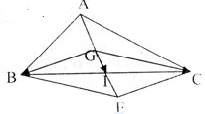Hãy nhập câu hỏi của bạn vào đây, nếu là tài khoản VIP, bạn sẽ được ưu tiên trả lời.

A B C I
Ta có: \(\overrightarrow{IA}=3.\overrightarrow{IB}\)
\(\overrightarrow{AB}=2.\overrightarrow{BI}\)
\(\Rightarrow\overrightarrow{BI}=\dfrac{1}{2}\overrightarrow{AB}\)
\(\Rightarrow\overrightarrow{CB}+\overrightarrow{BI}=\overrightarrow{CB}+\dfrac{1}{2}\overrightarrow{AB}\)
\(\Rightarrow\overrightarrow{CI}=\overrightarrow{CA}+\overrightarrow{AB}+\dfrac{1}{2}\overrightarrow{AB}\)
\(\Rightarrow\overrightarrow{CI}=\overrightarrow{CA}+\dfrac{3}{2}\overrightarrow{AB}\)
\(\Rightarrow\overrightarrow{CI}=\overrightarrow{CA}+\dfrac{3}{2}\overrightarrow{AC}+\dfrac{3}{2}\overrightarrow{CB}\)
\(\Rightarrow\overrightarrow{CI}=\overrightarrow{CA}-\dfrac{3}{2}\overrightarrow{CA}+\dfrac{3}{2}\overrightarrow{CB}\)
\(\Rightarrow\overrightarrow{CI}=\dfrac{-1}{2}\overrightarrow{CA}+\dfrac{3}{2}\overrightarrow{CB}\)
\(\Rightarrow\overrightarrow{CI}=\dfrac{1}{2}\left(3\overrightarrow{CB}-\overrightarrow{CA}\right)\)
\(\Rightarrow\) Đáp án B đúng

\(\overrightarrow{AD}=2\overrightarrow{DB}\Rightarrow\overrightarrow{AD}=\dfrac{2}{3}\overrightarrow{AB}\) ; \(\overrightarrow{CE}=3\overrightarrow{EA}\Rightarrow\overrightarrow{AE}=\dfrac{1}{4}\overrightarrow{AC}\)
Lại có M là trung điểm DE
\(\Rightarrow\overrightarrow{AM}=\dfrac{1}{2}\left(\overrightarrow{AD}+\overrightarrow{AE}\right)=\dfrac{1}{2}\left(\dfrac{2}{3}\overrightarrow{AB}+\dfrac{1}{4}\overrightarrow{AC}\right)=\dfrac{1}{3}\overrightarrow{AB}+\dfrac{1}{8}\overrightarrow{AC}\)
I là trung điểm BC \(\Rightarrow\overrightarrow{AI}=\dfrac{1}{2}\left(\overrightarrow{AB}+\overrightarrow{AC}\right)\)
\(\Rightarrow\overrightarrow{MI}=\overrightarrow{MA}+\overrightarrow{AI}=\overrightarrow{AI}-\overrightarrow{AM}=\dfrac{1}{2}\overrightarrow{AB}+\dfrac{1}{2}\overrightarrow{AC}-\dfrac{1}{3}\overrightarrow{AB}-\dfrac{1}{8}\overrightarrow{AC}=\dfrac{1}{6}\overrightarrow{AB}+\dfrac{3}{8}\overrightarrow{AC}\)

Lời giải:
a) Kéo dài $AG$ cắt $BC$ tại trung điểm $M$. Hiển nhiên $\overrightarrow{BM}, \overrightarrow{CM}$ là vecto đối nên tổng bằng vecto không.
Theo tính chất trọng tâm ta có:
$\overrightarrow{AI}=\frac{1}{2}\overrightarrow{AG}=\frac{1}{2}.\frac{2}{3}\overrightarrow{AM}=\frac{1}{3}\overrightarrow{AM}$
$=\frac{1}{6}(\overrightarrow{AM}+\overrightarrow{AM})=\frac{1}{6}(\overrightarrow{AB}+\overrightarrow{BM}+\overrightarrow{AC}+\overrightarrow{CM})$
$=\frac{1}{6}(\overrightarrow{AB}+\overrightarrow{AC})$
$=\frac{1}{6}(\overrightarrow{AC}+\overrightarrow{CB}+\overrightarrow{AC})$
$=\frac{1}{6}(2\overrightarrow{AC}+\overrightarrow{CB})$
$=\frac{-1}{3}\overrightarrow{CA}+\frac{1}{6}\overrightarrow{CB}$
$=\frac{-1}{3}\overrightarrow{a}+\frac{1}{6}\overrightarrow{b}$
----------------------
$\overrightarrow{AK}=\frac{1}{5}\overrightarrow{AB}=\frac{1}{5}(\overrightarrow{AC}+\overrightarrow{CB})=\frac{1}{5}(-\overrightarrow{CA}+\overrightarrow{CB})$
$=\frac{-1}{5}\overrightarrow{a}+\frac{1}{5}\overrightarrow{b}$
------------------
$\overrightarrow{CI}=\overrightarrow{CA}+\overrightarrow{AI}=\overrightarrow{a}-\frac{1}{3}\overrightarrow{a}+\frac{1}{6}\overrightarrow{b}$
$=\frac{2}{3}\overrightarrow{a}+\frac{1}{6}\overrightarrow{b}$
-------------------
$\overrightarrow{CK}=\overrightarrow{CA}+\overrightarrow{AK}=\overrightarrow{a}-\frac{1}{5}\overrightarrow{a}+\frac{1}{5}\overrightarrow{b}=\frac{4}{5}\overrightarrow{a}+\frac{1}{5}\overrightarrow{b}$
b)
Từ phần a ta thấy: $\overrightarrow{CI}=\frac{5}{6}\overrightarrrow{CK}$ nên $C,I,K$ thẳng hàng.

Câu 1:
Theo tính chất trọng tâm và đường trung tuyến, ta thấy \(\overrightarrow {AM}; \overrightarrow{GM}\) là 2 vecto cùng phương, cùng hướng và \(AM=3GM\)
\(\Rightarrow \overrightarrow{AM}=3\overrightarrow{GM}\)
\(=\frac{3}{2}(\overrightarrow{GM}+\overrightarrow{GM})\) \(=\frac{3}{2}(\overrightarrow{GB}+\overrightarrow{BM}+\overrightarrow{GC}+\overrightarrow{CM})\)
\(=\frac{3}{2}[(\overrightarrow{GB}+\overrightarrow{GC})+(\overrightarrow{BM}+\overrightarrow{CM})]\)
\(=\frac{3}{2}(\overrightarrow{GB}+\overrightarrow{GC})\) (vecto \(\overrightarrow{BM}; \overrightarrow{CM}\) là 2 vecto đối nhau nên tổng bằng vecto $0$)
Đáp án B
Câu 2:
\(\overrightarrow{u}=\overrightarrow{AB}+\overrightarrow{DC}+\overrightarrow{BD}+\overrightarrow{CA}\)
\(=(\overrightarrow{AB}+\overrightarrow{BD})+(\overrightarrow{DC}+\overrightarrow{CA})=\overrightarrow{AD}+\overrightarrow{DA}\)
\(=\overrightarrow{0}\) (tổng của 2 vecto đối nhau)
Đáp án C
Câu 3:
Bạn nhớ rằng \(\overrightarrow{a}; k\overrightarrow{a}(k\in\mathbb{R})\) luôn là 2 vecto cùng phương (tính chất vecto). Nhưng nó mới chỉ là cùng phương thôi. Muốn cùng phương +cùng hướng thì \(k>0\) ; muốn cùng phương + ngược hướng thì \(k< 0\). Nói chung là phụ thuộc vào tính chất của $k$
Câu C thì hiển nhiên sai.
Nên đáp án B đúng

Lời giải:
Với $I$ là trung điểm của $BC$ thì \(\overrightarrow{IB}+\overrightarrow{IC}=\overrightarrow{0}\)
Ta có:
\(\overrightarrow{AB}+\overrightarrow{AC}=\overrightarrow{AI}+\overrightarrow{IB}+\overrightarrow{AI}+\overrightarrow{IC}\)
\(=2\overrightarrow{AI}+(\overrightarrow{IB}+\overrightarrow{IC})\)
\(=2\overrightarrow{AI}\)
\(\Rightarrow \overrightarrow{AI}=\frac{1}{2}\overrightarrow{AB}+\frac{1}{2}\overrightarrow{AC}\) (đpcm)
b) Gọi giao điểm của $AG$ với $BC$ là $T$
\(\overrightarrow{AB}+\overrightarrow{AC}=\overrightarrow{AG}+\overrightarrow{GB}+\overrightarrow{AG}+\overrightarrow{GC}\)
\(=2\overrightarrow{AG}+\overrightarrow{GB}+\overrightarrow{GC}=2\overrightarrow{AG}+\overrightarrow{GI}+\overrightarrow{IB}+\overrightarrow{GI}+\overrightarrow{IC}\)
\(=2\overrightarrow{AG}+2\overrightarrow{GI}\)
Theo tính chất đường trung tuyến thì \(\overrightarrow{AG}=2\overrightarrow{GI}\) nên:
\(\overrightarrow{AB}+\overrightarrow{AC}=2\overrightarrow{AG}+\overrightarrow{AG}=3\overrightarrow{AG}\)
\(\Rightarrow \overrightarrow{AG}=\frac{1}{3}\overrightarrow{AB}+\frac{1}{3}\overrightarrow{AC}\)


Gọi M là trung điểm AB \(\Rightarrow\overrightarrow{CG}=\dfrac{2}{3}\overrightarrow{CM}\)
Mà \(\overrightarrow{CM}=\dfrac{1}{2}\left(\overrightarrow{CA}+\overrightarrow{CB}\right)\) \(\Rightarrow\overrightarrow{CG}=\dfrac{1}{3}\overrightarrow{CA}+\dfrac{1}{3}\overrightarrow{CB}\)
Do I là trung điểm AG:
\(\overrightarrow{CI}=\dfrac{1}{2}\overrightarrow{CG}+\dfrac{1}{2}\overrightarrow{CA}=\dfrac{1}{2}\left(\dfrac{1}{3}\overrightarrow{CA}+\dfrac{1}{3}\overrightarrow{CB}\right)+\dfrac{1}{2}\overrightarrow{CA}=\dfrac{2}{3}\overrightarrow{CA}+\dfrac{1}{6}\overrightarrow{CB}\)